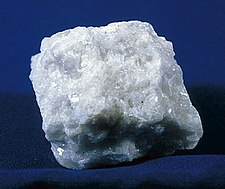Marble
From Wikipedia, the free encyclopedia
Marble is a metamorphic rock resulting from the metamorphism of limestone, composed mostly of calcite (a crystalline form of calcium carbonate, CaCO3). It is extensively used for sculpture, as a building material, and in many other applications. The word 'marble' is colloquially used to refer to many other stones that are capable of taking a high polish.
Faux marble or faux marbling is a wall painting technique that imitates the color patterns of real marble (not to be confused with paper marbling). Marble dust can be combined with cement or synthetic resins to make reconstituted or cultured marble.
Places named after the stone include Marble Arch, London; the Sea of Marmara; India's Marble Rocks; and the towns of Marble, Minnesota; Marble, Colorado; and Marble Hill, Manhattan, New York. The Elgin Marbles are marble sculptures from the Parthenon that are on display in the British Museum. They were brought to Britain by the Earl of Elgin.
Contents[hide] |
[edit] Origins
Marble is a metamorphic rock resulting from regional or rarely contact metamorphism of sedimentary carbonate rocks, either limestone or dolostone. This metamorphic process causes a complete recrystallization of the original rock into an interlocking mosaic of calcite, aragonite and/or dolomite crystals. The temperatures and pressures necessary to form marble usually destroy any fossils and sedimentary textures present in the original rock.
Pure white marble is the result of metamorphism of very pure limestones. The characteristic swirls and veins of many colored marble varieties are usually due to various mineral impurities such as clay, silt, sand, iron oxides, or chert which were originally present as grains or layers in the limestone. Green coloration is often due to serpentine resulting from originally high magnesium limestone or dolostone with silica impurities. These various impurities have been mobilized and recrystallized by the intense pressure and heat of the metamorphism.
[edit] Kinds of marble
Some historically important kinds of marble, named after the locations of their quarries, include:
- Durango Marble from Coyote Quarry, Mexico
- Thassos from Greece
- Paros from Greece
- Rouge de Rance from Rance, Belgium
- Penteli from Greece
- Carrara and Luni from Italy
- Proconnesus from Turkey
- Connemara from Ireland
- Brač from the island of Brač, Croatia
- Black Marble from Kilkenny, Ireland
- Macael from Spain
- Makrana from India
- Boticena and Onyx(Green) from Pakistan
- Danby from Vermont
- Yule from Colorado
- Royal White from China
- Beijing White from China
- Vietnam White from Vietnam
- Llano Pink from Central Texas
White marbles, like Carrara in Italy, Royal White and Bejing White in China, have been prized for sculpture since classical times. This preference has to do with the softness and relative isotropy and homogeneity, and a relative resistance to shattering. Also, the low index of refraction of calcite allows light to penetrate several millimeters into the stone before being scattered out, resulting in the characteristic "waxy" look which gives "life" to marble sculptures of the human body.
[edit] Construction marble
In the construction trade, the term "marble" is used for any massive, crystalline calcitic rock (and some non-calcitic rocks) useful as building stone. For example, Tennessee Marble is really a massive, highly fossiliferous gray to pink to maroon Ordovician dolostone, known as the Holston Formation by geologists.
[edit] Industrial use of marble
Colorless marbles are a very pure source of calcium carbonate, which is used in a wide variety of industries. Finely ground marble powder is a component in paints, toothpaste, and plastics; calcium carbonate can also be reduced under high heat to calcium oxide (also known as "lime"), which has many applications including being a primary component of most cements.
[edit] Etymology
The word "marble" derives from the Greek marmaros, "shining stone" (OED). This stem is also the basis for the English word "marmoreal" meaning "marble-like".
[edit] Cultural associations
As the favorite medium for Greek and Roman sculptors and architects, marble has become a cultural symbol of tradition and refined taste. Its extremely varied and colorful patterns make it a favorite decorative material, and it is often imitated in background patterns for computer displays, etc.
In folklore, marble is associated with the astrological sign of Gemini. Pure white marble is an emblem of purity. It is also an emblem of immortality, and an insurer of success in education.




No comments:
Post a Comment